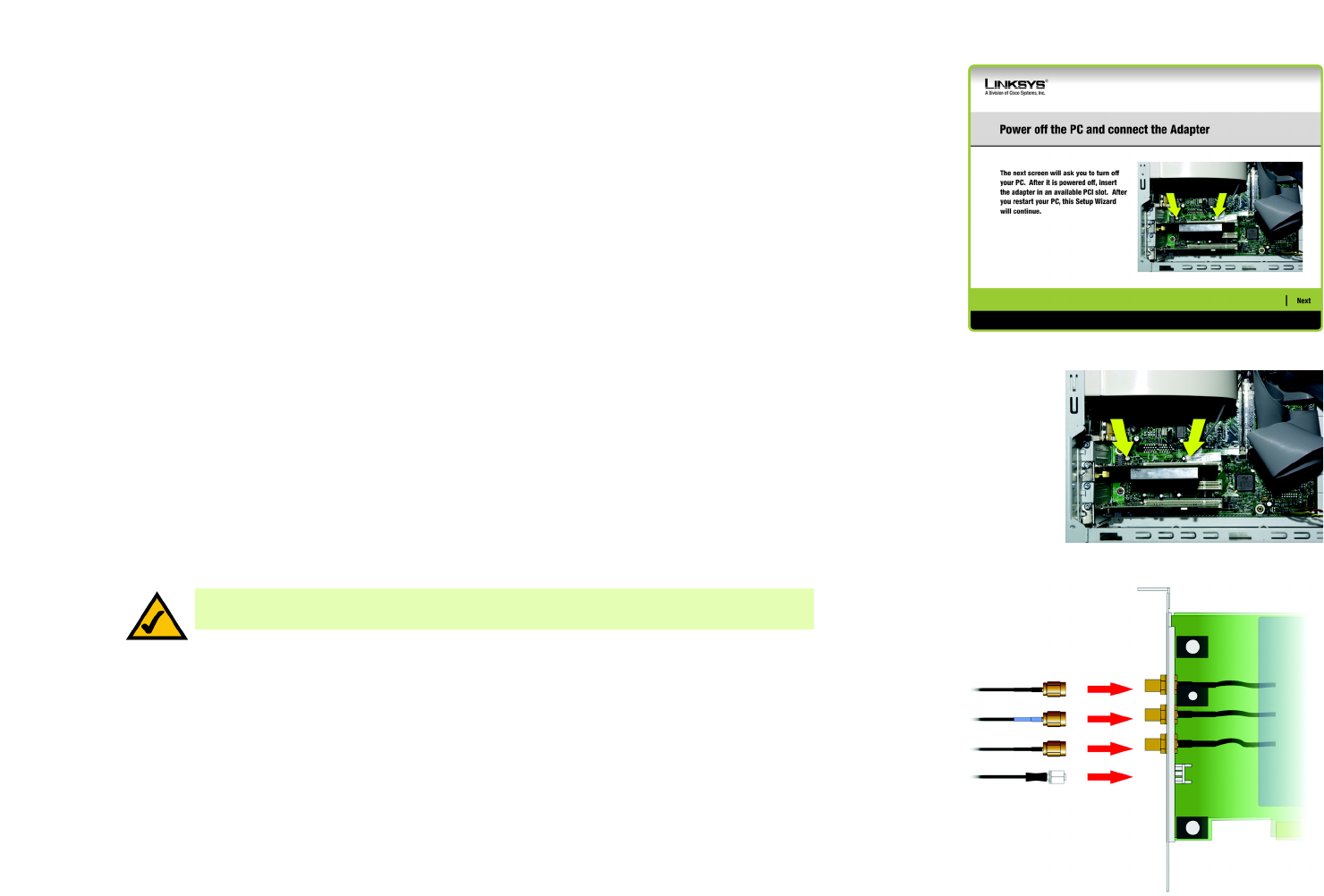LINKSYS HGA7S-WMP54GX Wireless-G PCI Adapter with SRX User Manual Book
LINKSYS LLC Wireless-G PCI Adapter with SRX Book
LINKSYS >
Contents
- 1. Users Manual 1
- 2. Users Manual 2
- 3. Users Manual 3
- 4. Users Manual 4
Users Manual 2

6
Chapter 4: Setting Up and Connecting the Wireless-G PCI Adapter with SRX
Starting the Setup Wizard
Wireless-G PCI Adapter with SRX
Chapter 4: Setting Up and Connecting the Wireless-G
PCI Adapter with SRX
The Wireless-G PCI Adapter is set up with the Setup Wizard that comes on the CD enclosed with the Adapter. This
chapter will guide you through the setup procedure.
Starting the Setup Wizard
To begin the setup process, insert the Setup Wizard CD-ROM into your CD-ROM drive. The Setup Wizard should
run automatically, and the Welcome screen should appear. If it does not, click the Start button and choose Run.
In the field that appears, enter D:\setup.exe (if “D” is the letter of your CD-ROM drive).
On the Welcome screen, you have the following choices:
Click Here to Start - Click the Click Here to Start button to begin the software installation process.
User Guide - Click the User Guide button to open this User Guide.
Exit - Click Exit to exit the Setup Wizard.
1. To install the Adapter, click the Click Here to Start button on the Welcome screen.
2. After reading the License Agreement, click Next if you agree and want to continue the installation, or click
Cancel to end the installation.
Figure 4-1: Setup Wizard’s Welcome Screen
Figure 4-2: Setup Wizard’s License Agreement
IMPORTANT: Do not connect the Adapter until you are instructed to
do so or the setup will not work.

7
Chapter 4: Setting Up and Connecting the Wireless-G PCI Adapter with SRX
Installing the Adapter
Wireless-G PCI Adapter with SRX
3. Windows will begin copying the files onto your PC.
4. The Setup Wizard will now prompt you to install the Adapter into your PC. Click Next and power off your PC.
After installing the Adapter, as shown below, and restarting your PC, the Setup Wizard will continue.
Installing the Adapter
1. If you haven’t already done so, power off your desktop PC before installing the Adapter.
2. Open your PC case and locate an available PCI slot on the motherboard. Check with your computer
manufacturer for instructions.
3. Slide the Adapter into the PCI slot. Make sure that all of its pins are touching the slot's contacts. You may have
to apply a bit of pressure to slide the Adapter all the way in. After the Adapter is firmly in place, secure its
fastening tab to your PC's chassis with a mounting screw. Then, close your PC.
4. Now you will connect the antenna stand’s cables to the PCI card part of the Adapter. Plug the cable with the
white connector into the ACT. port (also white). Then attach the remaining cables to the Adapter’s ANT. ports.
5. Attach the antennas to the connectors on the antenna stand.
6. Power on your desktop PC.
Figure 4-3: Connecting the Adapter Screen
Figure 4-4: Installing the Adapter
Figure 4-5: Attaching the Antenna Cables
NOTE: Only the cable with the white connector must plug into the white ACT. port. Then
you can connect any of the other antenna cables to any of the Adapter’s ANT. ports.

8
Chapter 4: Setting Up and Connecting the Wireless-G PCI Adapter with SRX
Setting Up the Adapter
Wireless-G PCI Adapter with SRX
Setting Up the Adapter
When the Setup Wizard resumes, the next screen to appear will be the Available Wireless Network screen.
This screen provides two options for setting up the Adapter.
•Available Wireless Network. Most users should use this option. The networks available to this Adapter will
be listed on this screen. You can choose one of these networks and click the Connect button to connect to it.
Click the Refresh button to update the Available Wireless Network list.
•Manual Setup. To set up the Adapter manually, select Manual Setup.
The setup for each option is described, step by step, under the appropriate heading on the following pages.
Click Exit to close the Setup Wizard, if you wish to set up the Adapter later.
Figure 4-6: Available Wireless Network Screen

9
Chapter 4: Setting Up and Connecting the Wireless-G PCI Adapter with SRX
Setting Up the Adapter
Wireless-G PCI Adapter with SRX
Setting Up the Adapter with an Available Network
The available networks are listed in the table on the center of the screen by SSID. Select the wireless network
you wish to connect to and click the Connect button. (If you do not see your network listed, you can click the
Refresh button to bring the list up again.) If the network utilizes wireless security, you will need to configure
security on the Adapter. If not, you will be taken directly to the Congratulations screen.
1. If wireless security has been enabled on this network, you will see a wireless security screen. If your network
uses WEP (Wired Equivalent Privacy) encryption, the WEP Key Needed for Connection screen will appear. If
your network uses WPA Personal or WPA2 Personal security, a screen will appear for one of those encryption
methods.
WEP Key Needed for Connection
Select the level of encryption you want to use, 64-bit or 128-bit.
Then, enter a passphrase or WEP key.
Passphrase - Enter a passphrase in the Passphrase field, so a WEP key is automatically generated. The
passphrase is case-sensitive and should not be longer than 31 alphanumeric characters. It must match the
passphrase of your other wireless network devices and is compatible with Linksys wireless products only. (If
you have any non-Linksys wireless products, enter the WEP key manually on those products.)
WEP Key 1 - The WEP key you enter must match the WEP key of your wireless network. For 64-bit
encryption, enter exactly 10 hexadecimal characters. For 128-bit encryption, enter exactly 26 hexadecimal
characters. Valid hexadecimal characters are “0” to “9” and “A” to “F”.
Then, click Connect and proceed to the Congratulations screen. To cancel the connection, click Cancel.
Figure 4-7: Available Wireless Network Screen
Figure 4-8: WEP Key Needed for Connection
wep (wired equivalent privacy): a method of encrypting
network data transmitted on a wireless network for
greater security.
encryption: encoding data transmitted in a network.
wpa (wi-fi protected access): a wireless security
protocol using TKIP (Temporal Key Integrity Protocol)
encryption, which can be used in conjunction with a
RADIUS server.

10
Chapter 4: Setting Up and Connecting the Wireless-G PCI Adapter with SRX
Setting Up the Adapter
Wireless-G PCI Adapter with SRX
WPA-Personal for Connection
WPA Personal offers two encryption methods, TKIP and AES, with dynamic encryption keys. Select one of
these methods. Then enter a passphrase.
Encryption - Select the type of algorithm you want to use, TKIP or AES, from the Encryption drop-down
menu.
Passphrase - Enter a Passphrase, also called a pre-shared key, of 8-63 characters in the Passphrase field.
The longer and more complex your Passphrase is, the more secure your network will be.
Then, click Connect and proceed to the Congratulations screen. To cancel the connection, click Cancel.
WPA2 - Personal Needed for Connection
AES is automatically used as the encryption method. Enter a passphrase on this screen.
Passphrase - Enter a Passphrase, also called a pre-shared key, of 8-63 characters in the Passphrase field.
The longer and more complex your Passphrase is, the more secure your network will be.
Then, click Connect and proceed to the Congratulations screen. To cancel the connection, click Cancel.
2. After the Adapter has been configured for the network, the Congratulations screen will appear. Click Connect
to Network to connect to your network.
Congratulations! Setup is complete.
To check the link information, search for available wireless networks, or make additional configuration
changes, refer to “Chapter 5: Using the Wireless Network Monitor.”
Figure 4-9: WPA-Personal Needed for Connection
Figure 4-11: Congratulations Screen
Figure 4-10: WPA2-Personal Needed for Connection

11
Chapter 4: Setting Up and Connecting the Wireless-G PCI Adapter with SRX
Setting Up the Adapter
Wireless-G PCI Adapter with SRX
Setting Up the Adapter with Manual Setup
Click Manual Setup on the Available Wireless Network screen to set up the Adapter manually.
1. After clicking Manual Setup, the Network Settings screen will appear. If your network has a router or other
DHCP server, click the radio button next to Obtain network settings automatically (DHCP).
If your network does not have a DHCP server, click the radio button next to Specify network settings. Enter
an IP Address, Subnet Mask, Default Gateway, and DNS addresses appropriate for your network. You must
specify the IP Address and Subnet Mask on this screen. If you are unsure about the Default Gateway and DNS
addresses, leave these fields empty.
IP Address - This IP Address must be unique to your network.
Subnet Mask - The Adapter’s Subnet Mask must be the same as your wired network’s Subnet Mask.
Default Gateway - Enter the IP address of your network’s Gateway here.
DNS 1 and DNS 2 - Enter the DNS address of your wired Ethernet network here.
Click Next to continue, or click Back to return to the Available Wireless Network screen.
Figure 4-12: Available Wireless Network Screen
Figure 4-13: Network Settings Screen
ip address: the address used to identify a computer or
device on a network.
default gateway: a device that forwards
Internet traffic from your local area network.
dns (domain name server): the IP address of your ISP's server,
which translates the names of websites into IP addresses.
subnet mask: an address code that determines the size of
a network.

12
Chapter 4: Setting Up and Connecting the Wireless-G PCI Adapter with SRX
Setting Up the Adapter
Wireless-G PCI Adapter with SRX
2. The Wireless Mode screen shows a choice of two wireless modes. Click the Infrastructure Mode radio
button if you want to connect to a wireless router or access point. Click the Ad-Hoc Mode radio button if you
want to connect to another wireless device directly without using a wireless router or access point. Then,
enter the SSID for your network.
Infrastructure Mode - Use this mode if you want to connect to a wireless router or access point.
Ad-Hoc Mode - Use this mode if you want to connect to another wireless device directly without using a
wireless router or access point.
SSID - This is the wireless network name that must be used for all the devices in your wireless network. It is
case- sensitive and should be a unique name to help prevent others from entering your network.
Click Next to continue or Back to return to the previous screen.
3. If you chose Infrastructure Mode, go to Step 4 now. If you chose Ad-Hoc Mode, the Ad-Hoc Mode Settings
screen will appear. Select your channel and network mode settings on this screen.
Channel - Select the correct channel for your wireless network. The channel you choose should match the
channel set on the other devices in your wireless network. If you are unsure about which channel to use, keep
the default setting.
Network Mode - Select the mode in which your wireless network will operate. Select Mixed Mode if you
want both Wireless-B and Wireless-G devices operating on the network, though at a slower speed. Select G-
Only Mode if you do not want any Wireless-B devices operating on the network.
Click Next to continue or click Back to change any settings.
Figure 4-14: Wireless Mode Screen
Figure 4-15: Ad-Hoc Mode Settings Screen

13
Chapter 4: Setting Up and Connecting the Wireless-G PCI Adapter with SRX
Setting Up the Adapter
Wireless-G PCI Adapter with SRX
4. The Wireless Security screen will appear.
If your wireless network doesn’t use wireless security, select Disabled and then click the Next button to
continue. Proceed to Step 5.
From the Security drop-down menu, select the security method you want to use: WEP, WPA Personal, WPA2
Personal, WPA Enterprise, or RADIUS. WEP stands for Wired Equivalent Privacy, and WPA uses a security
standard stronger than WEP encryption. RADIUS stands for Remote Authentication Dial-In User Service. Then
proceed to the appropriate instructions for your security method.
WEP
Select a level of WEP encryption to use, and then enter a passphrase or WEP key.
WEP - To use WEP encryption, select 64-bit or 128-bit characters from the drop-down menu.
Passphrase - Instead of manually entering a WEP key, you can enter a passphrase in the Passphrase field,
so a WEP key is automatically generated. This case-sensitive passphrase must match the passphrase of your
other wireless network devices and is compatible with Linksys wireless products only. (If you have any non-
Linksys wireless products, enter the WEP key manually on those products.)
WEP Key- The WEP key you enter must match the WEP key of your wireless network. If you are using 64-bit
WEP encryption, then the key must consist of exactly 10 hexadecimal characters. If you are using 128-bit
WEP encryption, then the key must consist of exactly 26 hexadecimal characters. Valid hexadecimal
characters are “0” to “9” and “A” to “F”.
Advanced Users:
TX Key - The default transmit key number is 1. If your network’s access point or wireless router uses
transmit key number 2, 3, or 4, select the appropriate number from the TX Key drop-down box.
Authentication - The default is set to Auto, where it auto-detects for Shared Key or Open system. Shared
Key is when both the sender and the recipient share a WEP key for authentication. Open key is when the
sender and the recipient do not share a WEP key for authentication. All devices on your network must use the
same authentication type.
Click the Next button to continue to the Confirm New Settings screen or the Back button to return to the
previous screen.
Figure 4-16: Wireless Security Screen
Figure 4-17: Wireless Security - WEP Screen